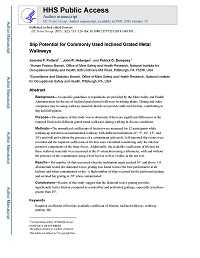Mining Publication: Slip Potential for Commonly Used Inclined Grated Metal Walkways
Original creation date: April 2015
Background
No specific guidelines or regulations are provided by the Mine Safety and Health Administration for the use of inclined grated metal walkways in mining plants. Mining and other companies may be using walkway materials that do not provide sufficient friction, contributing to slip and fall injuries.
Purpose
The purpose of this study was to determine if there are significant differences in the required friction for different grated metal walkways during walking in diverse conditions.
Methods
The normalized coefficients of friction were measured for 12 participants while walking up and down an instrumented walkway with different inclinations (0°, 5°, 10°, 15°, and 20°) and with and without the presence of a contaminant (glycerol). Self-reported slip events were recorded and the required coefficients of friction were calculated considering only the anterior/posterior components of the shear forces. Additionally, the available coefficients of friction for these walkway materials were measured at the 0° orientation using a tribometer, with and without the presence of the contaminant, using a boot heel as well as Neolite as the test feet.
Results
The number of slips increased when the inclination angle reached 10° and above. Of all materials tested, the diamond weave grating was found to have the best performance at all inclines and when contaminated or dry. A high number of slips occurred for the perforated grating and serrated bar grating at 20° when contaminated.
Conclusions
Results of this study suggest that the diamond weave grating provides significantly better friction compared to serrated bar and perforated gratings, especially at inclines greater than 10°.
Authors: JP Pollard, J Heberger, PG Dempsey
Peer Reviewed Journal Article - April 2015
NIOSHTIC2 Number: 20047246
IIE Trans Occup Ergon Hum Factors 2015 Apr; 3(2):115-126
See Also
- Contributing Factors to Slip, Trip, and Fall Fatalities at Surface Coal and Metal/Nonmetal Mines
- Don't Slip Up!
- The Effect of Cap Lamp Lighting on Postural Control and Stability
- Falls Can Kill!
- Investigation of a Slip/Fall Accident
- Slip, Trip, and Fall Hazard Identification, Investigation, and Remediation at Surface Mining Facilities
- Visual Performance for Trip Hazard Detection When Using Incandescent and LED Miner Cap Lamps
- Content source: National Institute for Occupational Safety and Health, Mining Program


 ShareCompartir
ShareCompartir
